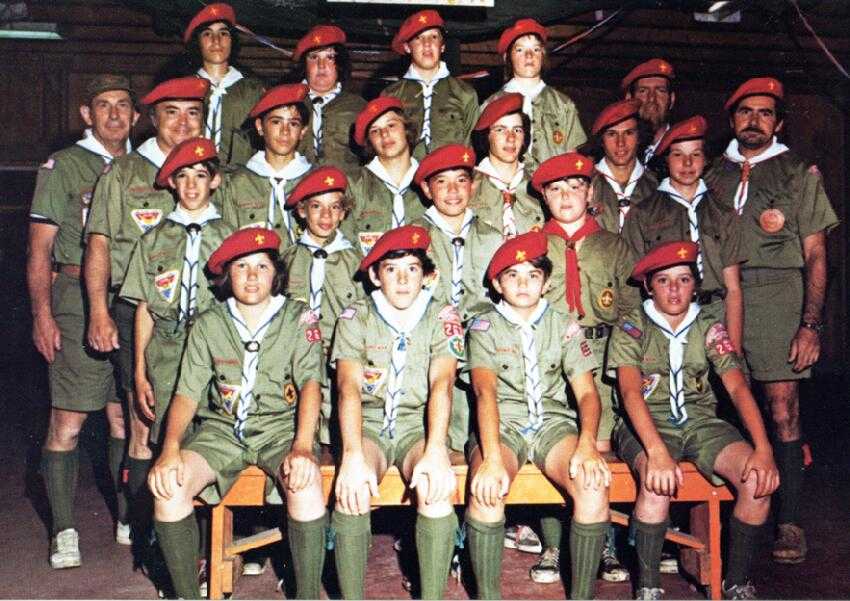Boy Scout Uniform Headwear: Berets
We note Scouts all around the world wearing beret headwear. And the different associations sometimes chose destinctive colors for their berets. They have been most commonly worn in Europe, but we notice Scouts in many other countries wearing them. Berets were first worn in France and Belgium, countriesd where the beret were an established headwear style. After World War II we notice many other countries adopting them. Some German Scouts wore them. And they were adopted by the important British Scouting movement. This helped popularize them in British Empire countries such as Canada, Many other countries adopted berets including the Thai Scouting movement. We notice American Scouts wearing destinctive bright red berets during the 1970s and 80s. They were not the official Scout headwear, but an optional style that units could adopt. We do not have a complete list, but have acquired some information on the berets Scouts wore in several different countries. The variation is not just by countries. Scouts changed uniforms ovedr times. In addition, many countries had multiple associations. And the various levels of Scouts jad uniform variations. We note several Air Scout groups in various countries with light-blue berets.
Austria
Boy Scouts and Girl Guides in Austria" wear blue berets.
Belgium
I assume Belgian Scouts like French Scouts wore berets, but I have no details on this.
Canada
Canadian Scouts wear dark green berets. I am not sure just when the beret was adopted by the Canadian Scout association.
England
English Scouts adopted black berets as part of the official uniform in 1969. English Cubs continued to wear the traditional peaked cap. The Scouts had been complaining about the lemon-squeezer hat because it was expensive and hard to maintain. English Scouts are now less interested in
the Scout uniform, but generally speaking the English Scouts take uniform more serious than other European Scouts.
France
The traditional Boy Scout hat was the lemon-squeezer hat designed by Lord Baden Powell. Scouts wore these hats for decades. Gradually different types of caps were introduced in various countries. One of the most popular alternatives to the traditional Scout hat was the beret. French Scouts wore berets from an early stage of the development of the Boy Scout movement. The beret was enitially seen as a French garment, which the English and most other countries would have nothing to do with. This changed after World War II and the beret, which is still worn by French Scouts, has become the most common headgear worn by Scouts around the world.
Ireland
Irish Catholic Scouts wear light blue berets. We see the boys wearing blue shirts and blusish-green berets. I'm not sure about other Irish Scouts. Some of the boys berets appear large and floppy. We are not sure just when the Irish Scouts adopted the beret as part of their uniform, but suspect it was the probably the 1960s. It is likely that they were influenced by the British Scout assiociation adopting the beret. We are not yet sure about other Irish Scout associations. Irish Cubs continue to wear the traditional peaked cap.
Italy
Some Italian Scouts have wore berets, primarily black ones. Italian Cubs wear the traditional peaked caps.
Netherlands
Some Dutch Scouts have worn black berets. I'm not sure if this was an official uniform or a decision by an individual unit. As in other European countries, uniform standards among Dutch Scouts have declined in recent years.
Thailand
United States
The red beret was one of the various types of headwear worn by American Boy Scouts. The traditional Boy Scout hat was the lemon-squeezer hat designed by Lord Baden Powell. (Americans now call it the Smokey Bear hat.) British, American. and other Scouts all over the world wore these hats for decades. This hat was adopted by the American Boy Scouts when the organization was initially established. It was worn through the 1930s. There were, however, problems associated with it. While it had considerable nostalgic value, it was expensive and was hard to keep looking smart--especially if it got wet. The BSA has since adopted different cap styles, including the campaign cap and finally the baseball cap currently used. The BSA during the 1970s and 80s allowed units to experiment with red berets in the 1970s. A number of units wanting a sharper look adopted it, but it was never adopted as the official BSA headwear. It could not be worn on a individual basis, only on a unit basis. Only a few units adopted it and after the mid-80s largely disappeared.
HBU
Navigate the Historic Boys' Uniform Web Site:
[Return to the Main Scout beret page]
[Return to the Main Scout headgear page]
[Activities]
[Biographies]
[Chronologies]
[Countries]
[Essays]
[Garments]
[Organizations]
[Religion]
[Other]
[Introduction]
[Bibliographies]
[Contributions]
[FAQs]
[Questions]
[Unknown images]
[Boys' Uniform Home]
Navigate the Historic Boys' Uniform Web chronological pages:
[1900s]
[1910s]
[1920s]
[1930s]
[1940s]
[1950s]
[1960s]
[1970s]
[1980s]
[1990s]
[2000s]
Created: 1:26 AM 11/17/2010
Last updated: 1:26 AM 11/17/2010


